Have you ever wondered why women no longer wear corsets like they did in the 19th century or why so many men have stopped wearing hats? Throughout history, certain events have left a lasting impact on what we wear today.
Join us as we discover the influence of these events. By understanding them, we can better appreciate how the past continues to inspire and drive the fashion world forward.
1. As women gained independence, corsets fell out of favor
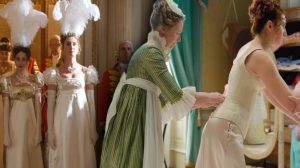
Corsets have played a crucial role in women’s fashion in Europe for many centuries. Their popularity soared during the Victorian era.
However, in the mid-19th century, corsets came under heavy criticism from the medical community. Doctors pointed out that wearing corsets, especially with tight-lacing, could harm women’s health.
They argued that it restricted lung expansion and led to the weakening of back and chest muscles.
In the 1900s, corsets began falling out of favor as women took a greater interest in sports and physical activities. The bicycle boom even inspired the development of the sports corset, designed to support the breasts while allowing more freedom of movement.
However, women soon preferred looser clothing that offered more comfort. To achieve a slim waist and hourglass figure, they turned to dieting and exercising rather than relying on restrictive garments.
By the 1910s and 1920s, many fashion designers abandoned the corset in their creations. Paul Poiret, a notable designer of that era, proudly claimed to be one of the pioneers in discarding the corset in favor of loose, draped fabrics.
The shift was further accelerated by World War I, as women started wearing uniforms and simpler cotton outfits instead of structured designs.
Consequently, corsets became less common, replaced by more practical and comfortable clothing choices.
2. Bikes popularized trousers for women
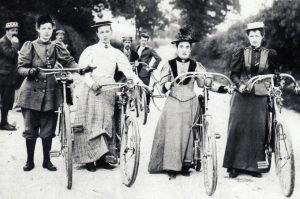
Back in the day, only guys rocked trousers from the get-go. Some places even made it a rule in their laws.
For many young women, especially those from well-off families, life was super supervised. But when cycling came into play, it changed the game.
Riding a bike gave women a taste of freedom they rarely got elsewhere.
Even though not everyone was cool with it at first, the idea caught on as more women took up cycling.
In 1851, an American named Amelia Bloomer shook things up. She wrote in her paper, The Lily, about changing up women’s clothes. She and her crew started wearing calf-length skirts over baggy pants called ‘Turkish trousers’.
People had mixed feelings about the look – some liked it, some laughed at it. Though it never became the norm, those baggy pants got dubbed ‘bloomers’. Soon enough, ‘bloomers’ meant not just pants, but also underpants and workout gear.
During the 19th century, as women learned more about how exercise keeps them healthy, they started getting into sports, especially bicycling.
As the 20th century kicked off, women began wearing full-length trousers. By the 1930s, it was totally normal for women to wear pants.
This change came about when famous actresses like Marlene Dietrich and Katharine Hepburn started rocking them. Then in 1939, Vogue magazine showed women wearing trousers in photos for the first time.
3. Theatrical props became fashionable
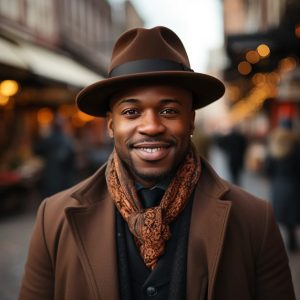
In the early 20th century, the Fedora hat was a staple in men’s fashion, seen everywhere from streets to gatherings. Its popularity soared when Prince Edward VIII of Wales adopted it as his signature headwear.
Interestingly, even before the Fedora gained widespread popularity among men in the 1880s, French theater actress Sarah Bernhardt was already making waves by wearing it.
Bernhardt’s portrayal of Fedora on stage included the soft felt hat as part of her costume, captivating audiences.
Beyond the stage, the Fedora hat found favor among female activists advocating for gender equality.
4. The rise of cars led men to ditch hats
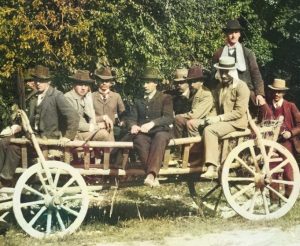
The late 1800s to the late 1920s marked a peak in hat-wearing culture. In 1912, it was uncommon to spot a man without a hat when he stepped out, while boys rocked caps.
From Fedoras to top hats, various styles were popular across all social classes. Historic photos from a century ago showcase this trend vividly, with hats adorning the heads of almost everyone.
However, the love affair with hats began to dwindle as time went on.
The rise of private car ownership played a significant role in the decline of hat popularity. With more men driving themselves, they no longer had to endure the cold and rain while waiting for buses.
But wearing a hat in a car became impractical due to low ceilings, rendering hats somewhat obsolete.
In the 1920s, only a tiny fraction of the population owned cars, but by 1940, a quarter did, and by 1970, over half did. Despite still purchasing hats, men found themselves donning them less frequently.
5. Coco Chanel revolutionized fashion with the elegant black dress
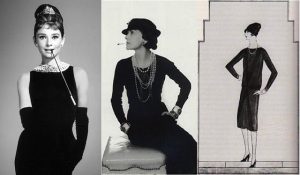
Around 1920, Chanel shared a memory with her friend Paul Morand about feeling overwhelmed by the vibrant colors at the Opera.
Chanel said, “At about that time, I remember contemplating the auditorium at the Opera from the back of a box…those reds, those greens, those electric blues made me feel ill. These colors are impossible. These women, I’m bloody well going to dress them in black…. I imposed black; it’s still going strong today, for black wipes out everything else around.”
Chanel and her contemporary, couturier Paul Poiret, had differing views on fashion during their time. Poiret favored vibrant colors and extravagant designs, flooding the market with his creations.
However, Chanel believed such flamboyant styles were more suitable for the stage than for everyday wear, famously stating, “the richer the dress, the poorer it becomes.”
Her preference for simplicity and elegance led her to champion the little black dress, famously remarking that crafting one was more challenging than imitating the captivating tales of Scheherazade.
Poiret, on the other hand, criticized Chanel’s creations, dismissing them as “deluxe poverty” and likening them to “little undernourished telegraph clerks.”
Despite initial resistance, the little black dress gained popularity after Vogue featured Chanel’s design in 1926, notably worn by actress Suzanne Orlandi in 1912–1913.
6. Twiggy’s slim figure caused a sensation
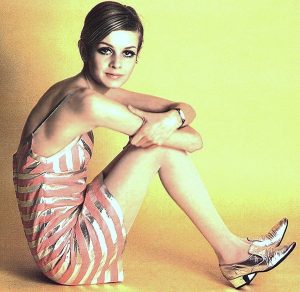
In 1966, Twiggy made a splash in the fashion world as the inaugural supermodel, setting a new standard for beauty.
Her slender frame, short haircut, and dramatic eyelashes captivated audiences, defining an entire generation and inspiring countless young women during the 60s revolution.
While luxury brands catered to affluent clientele, Twiggy, hailing from a working-class background, championed affordable, casual attire tailored for slim individuals.
Her influence extended beyond fashion, as women worldwide began aspiring to her slim physique, adopting short hairstyles, and embracing vibrant, short dresses.
Twiggy’s impact transcended the runway, shaping cultural norms and beauty standards for years to come.
“Before I was discovered, I wanted to be a dress designer,” Twiggy recalled. “I never planned to be a model. It was like a distant dream, but I thought I was much too thin, and much too small and too shy. Then fate took a hand and changed all that, but the obsession with designing and making clothes was always within me.”
7. Black sunglasses became trendy by concealing red eyes
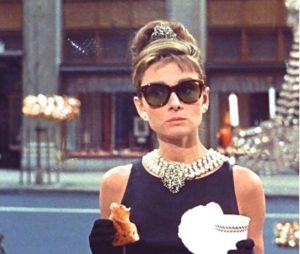
Sunglasses have become a stylish accessory, making everyone cooler. Some people wear them to shield their eyes from the sun’s glare, while others use them to add a touch of chicness to their outfits.
But have you ever wondered why sunglasses gained such popularity?
In the early 1920s, movie stars began sporting sunglasses not only to evade their fans but also to hide red eyes caused by the intense lights used on film sets. These powerful arc lights emitted bright light containing ultraviolet rays, causing actors’ eyes to redden.
The accessibility of sunglasses to the general public increased around 1929 when Sam Foster revolutionized their production, making them more affordable.
His affordable sunglasses quickly caught on as a glamorous Hollywood trend after he began selling them on Atlantic City beaches.
8. Board shorts were created for surfers
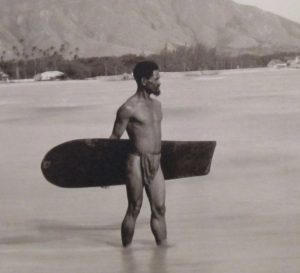
Surfers originally didn’t need trunks or boardshorts, following the ancient Hawaiians’ tradition of surfing naked. However, the arrival of missionaries led to a ban on naked surfing, sparking the need for clothing.
As watersports gained popularity in the early 20th century, surfing became a beloved pastime for many men, particularly in Hawaii.
In response to the demand for suitable attire, local tailors crafted shorts from thick canvas with waist lacing to withstand the impact of powerful waves.
These board shorts, designed to stay securely on the body, quickly became favored not only by surfers but also by beach enthusiasts.
9. Board shorts were created for surfers
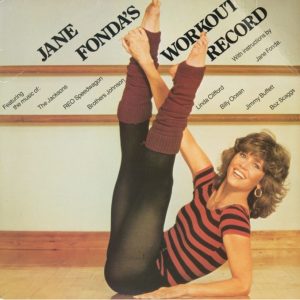
When Fonda released her workout video where she wore a striped leotard, black tights, and burgundy stirrup leg warmers, surrounded by energetic individuals, she sparked a fitness revolution.
Her aerobics lessons gained widespread attention, catapulting aerobics to global fame and making leggings a must-have fashion item for women everywhere.
“Jane Fonda’s Workout” wasn’t just about physical transformation for the millions who followed her routines; it was also a personal transformation for Fonda herself, transitioning from a model and award-winning actor to an activist.
“It was a pretty interesting time for me because people recognized me in a whole different way,” Fonda recalled in the 2018 HBO documentary “Jane Fonda In Five Acts.”

